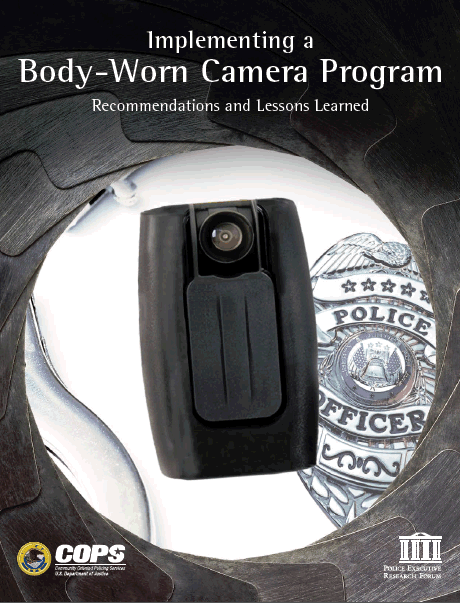
Over the past decade, advances in the technologies used by law enforcement agencies have been accelerating at an extremely rapid pace.
Many police executives are making decisions about whether to acquire technologies that did not exist when they began their careers?technologies like automated license plate readers, gunshot detection systems, facial recognition software, predictive analytics systems, communications systems that bring data to officers? laptops or handheld devices, GPS applications, and social media to investigate crimes and communicate with the public.
For many police executives, the biggest challenge is not deciding whether to adopt one particular technology but rather finding the right mix of technologies for a given jurisdiction based on its crime problems, funding levels, and other factors.
Finding the best mix of technologies, however, must begin with a thorough understanding of each type of technology.
Police leaders who have deployed body-worn cameras say there are many benefits associated with the devices. They note that body-worn cameras are useful for documenting evidence; officer training; preventing and resolving complaints brought by members of the public; and strengthening police transparency, performance, and accountability.
In addition, given that police now operate in a world in which anyone with a cell phone camera can record video footage of a police encounter, body-worn cameras help police departments ensure events are also captured from an officer?s perspective.
Scott Greenwood of the American Civil Liberties Union (ACLU) said at the September 2013 conference:
“The average interaction between an officer and a citizen in an urban area is already recorded in multiple ways. The citizen may record it on his phone. If there is some conflict happening, one or more witnesses may record it. Often there are fixed security cameras nearby that capture the interaction. So the thing that makes the most sense?if you really want accountability both for your officers and for the people they interact with?is to also have video from the officer?s perspective.”
The use of body-worn cameras also raises important questions about privacy and trust. What are the privacy issues associated with recording victims of crime? How can officers maintain positive community relationships if they are ordered to record almost every type of interaction with the public?
Will members of the public find it off-putting to be told by an officer, ?I am recording this encounter,? particularly if the encounter is a casual one?
Do body-worn cameras also undermine the trust between officers and their superiors within the police department?
In addition to these overarching issues, police leaders must also consider many practical policy issues, including the significant financial costs of deploying cameras and storing recorded data, training requirements, and rules and systems that must be adopted to ensure that body-worn camera video cannot be accessed for improper reasons.
In September 2014, the U.S. Department of Justice Office of Community Oriented Policing Services (COPS Office) released a publication Implementing a Body-Worn Camera Program: Recommendations and Lessons Learned.
The report analyzes some of the costs and benefits of law enforcement using body-worn video technology.
?Law enforcement agencies across the nation are contemplating how best to use body-worn cameras and these guidelines will help them weight the costs and benefits,? said COPS Office Director Ronald L. Davis. ?There are many considerations when implementing a body-worn camera and this report will help chiefs and sheriffs make the best decision for their jurisdiction.?
The publication was developed jointly by the Police Executive Research Forum (PERF) and Community Oriented Policing Services (COPS) through a cooperative agreement under the FY 2013 Community Policing Development Program.
PERF conducted research on the use of body-worn cameras, identified promising practices and lessons learned from the field and produced a set of guidelines for agencies interested in implement a body-worn camera program.
Included in this effort was a one-day executive session with more than 200 police chiefs, sheriffs, scholars, representatives from federal criminal justice agencies, and other experts present to share experiences and lessons learned about body-worn cameras, to identify promising practices from the field, and to engage in a dialog about the issues surrounding cameras.
The publication reviews the perceived benefits of body-worn cameras and considerations surrounding body-worn cameras before proposing a set of comprehensive policy recommendations that reflect the promising practices and lessons that emerged from PERF’s conference and its extensive discussions with police executives and other experts following the conference.
The policy recommendations cover all aspects of what a police department should consider when deciding to use body cameras including:
• Basic camera usage, such as who will be assigned to wear the cameras and where on the body the cameras are authorized to be placed;
• Recording protocols, including when to activate the camera, when to turn it off, and the types of circumstances in which recording is required, allowed or prohibited;
• The process for downloading recorded data from the camera, including who is responsible for downloading, when data must be downloaded, where data will be stored, and how to safeguard against data tampering or deletion;
• The length of time recorded data will be retained by the agency in various circumstances;
• The process and policies for accessing and reviewing recorded data, including the persons authorized to access data and the circumstances in which recorded data can be reviewed; and
• Policies for releasing recorded data to the public, including protocols regarding redactions and responding to public disclosure requests.
All COPS Office resources can be downloaded from the COPS Resource Center and many can be ordered at no-cost either through the Resource Center or by contacting the U.S. Department of Justice Response Center at 800.421.6770.
Source: publicintelligence.net
